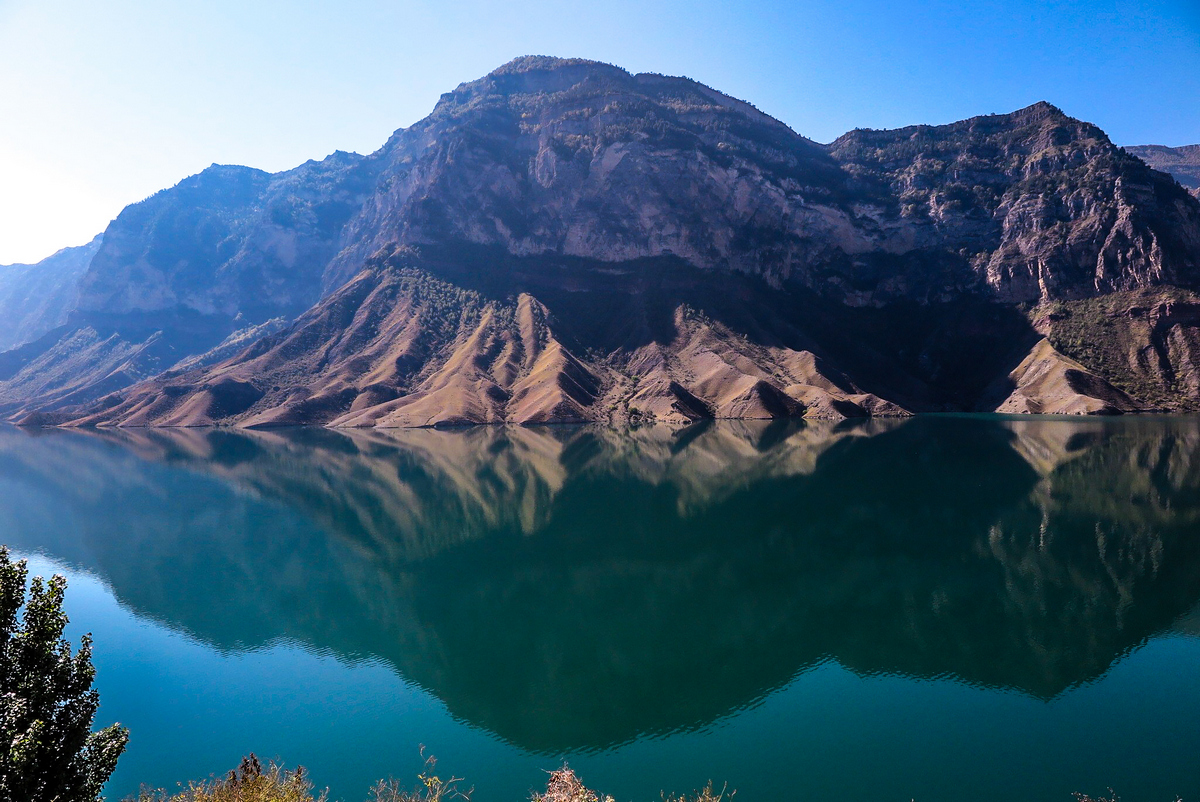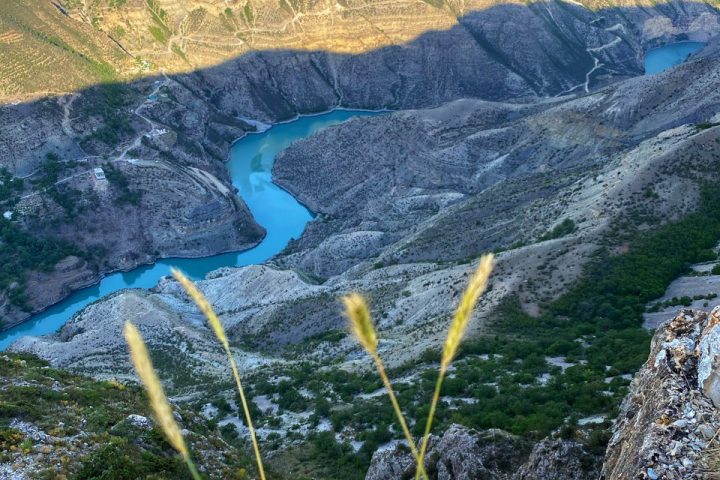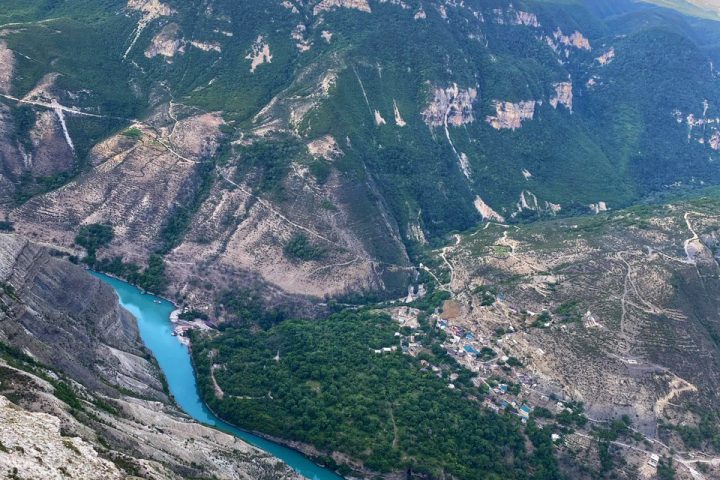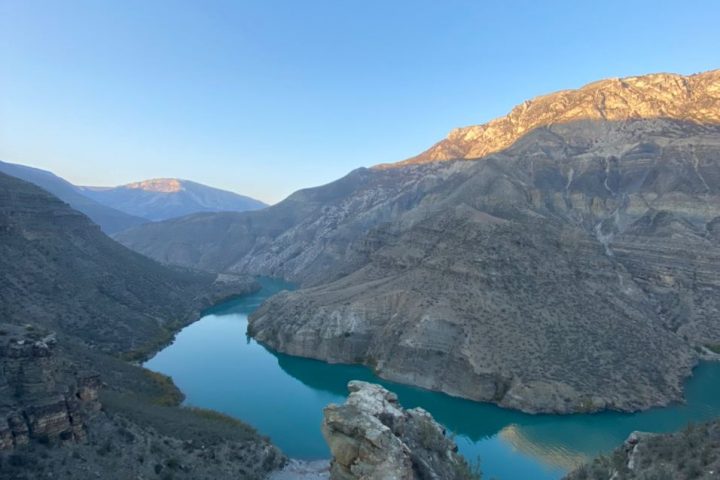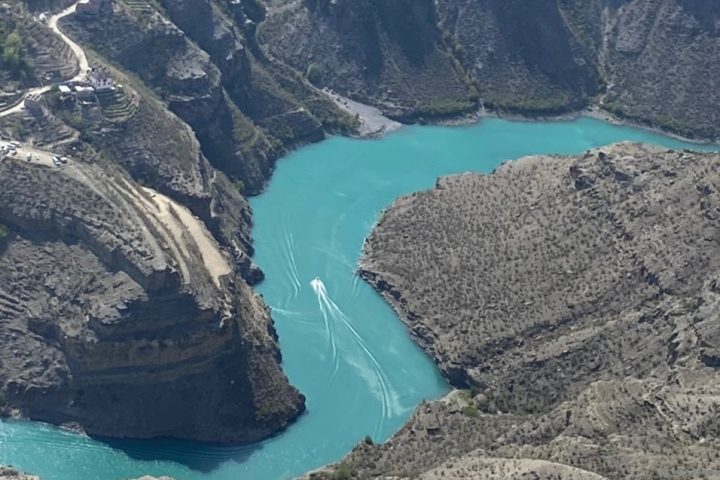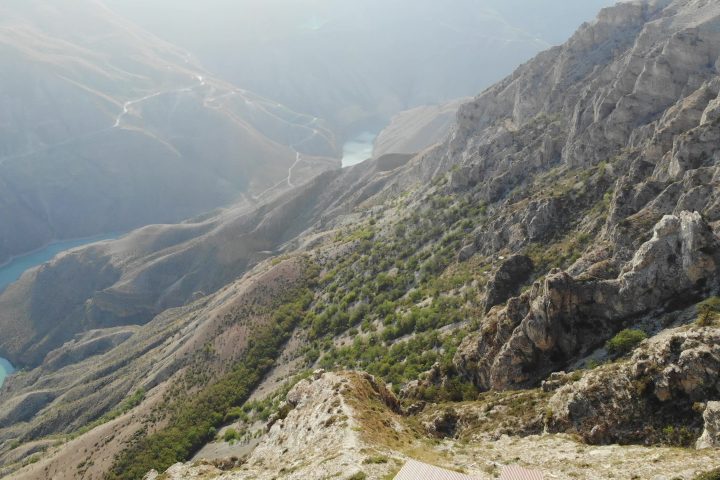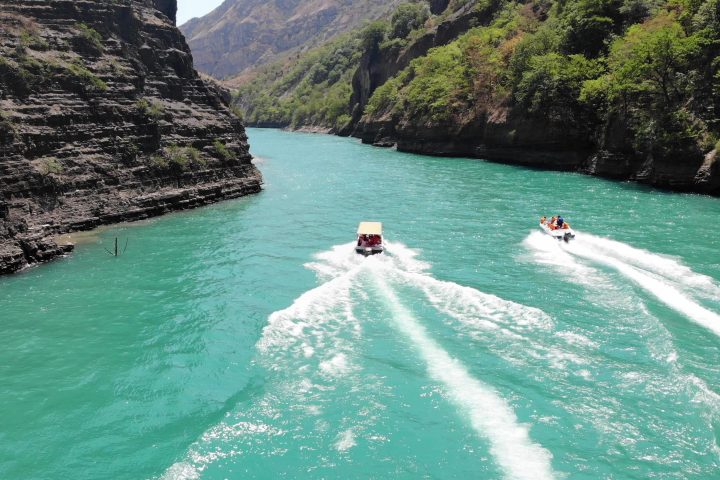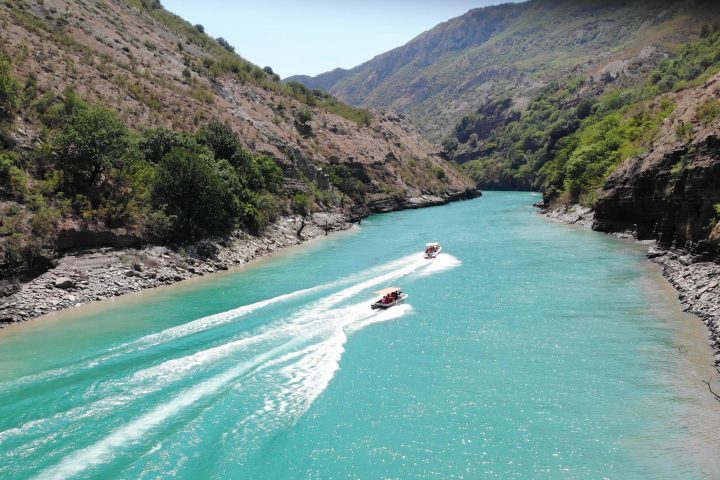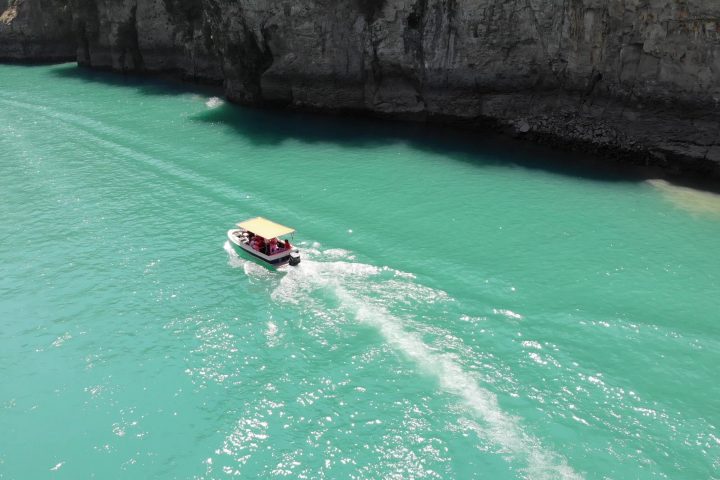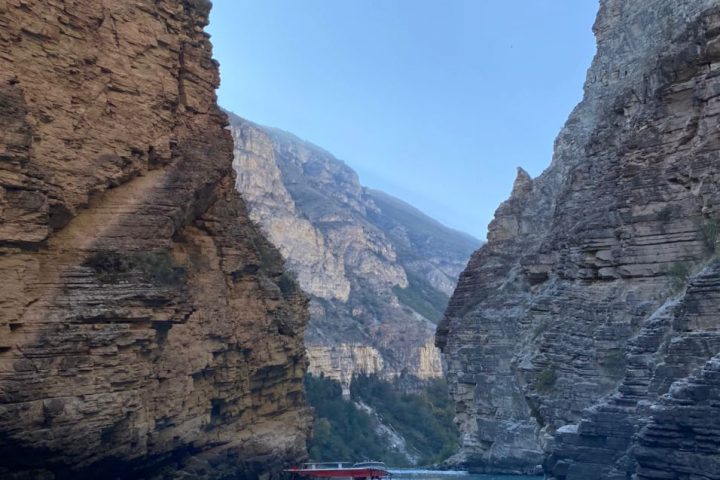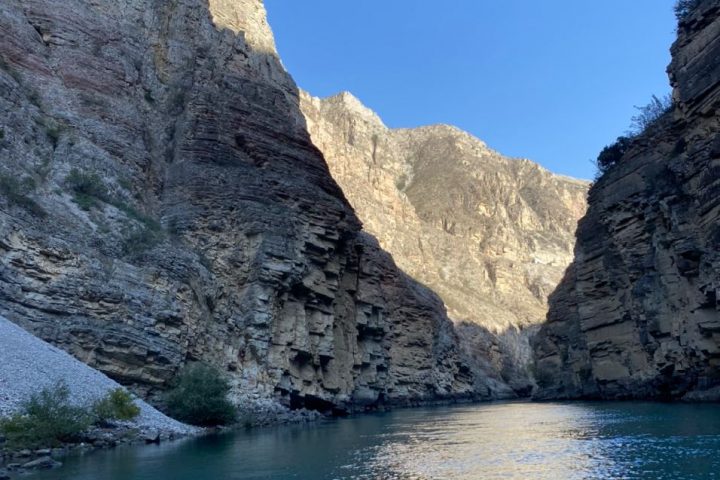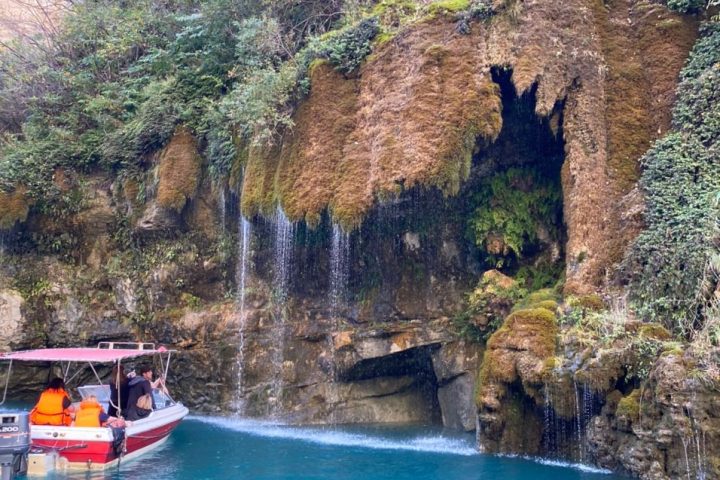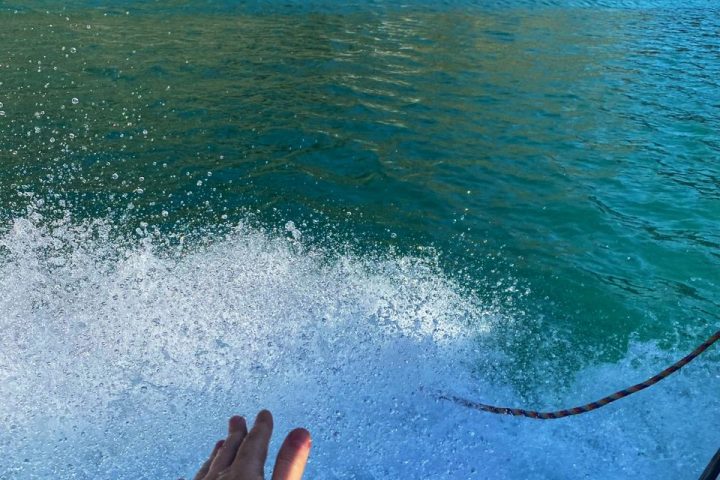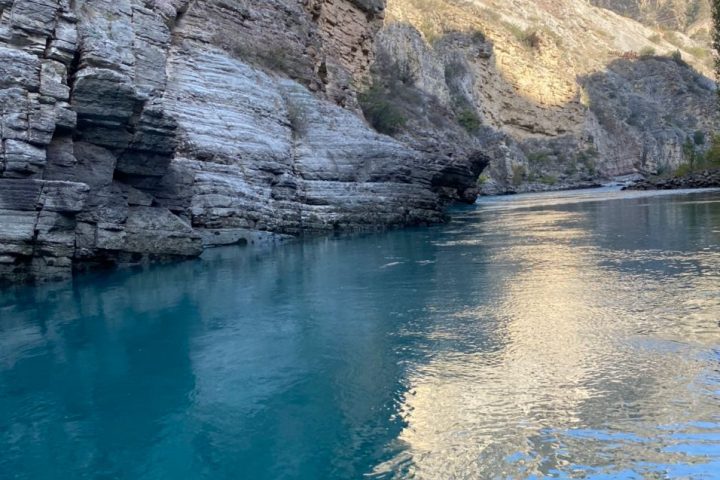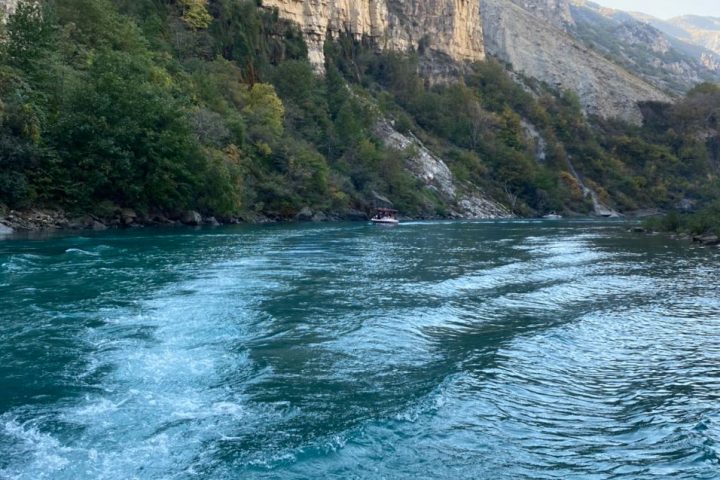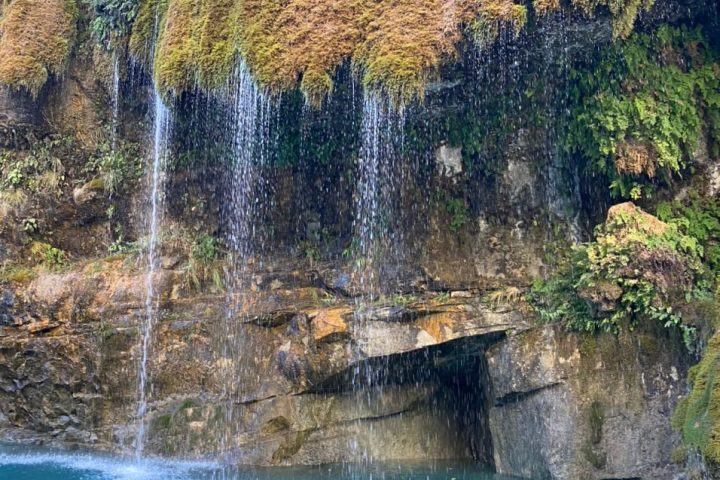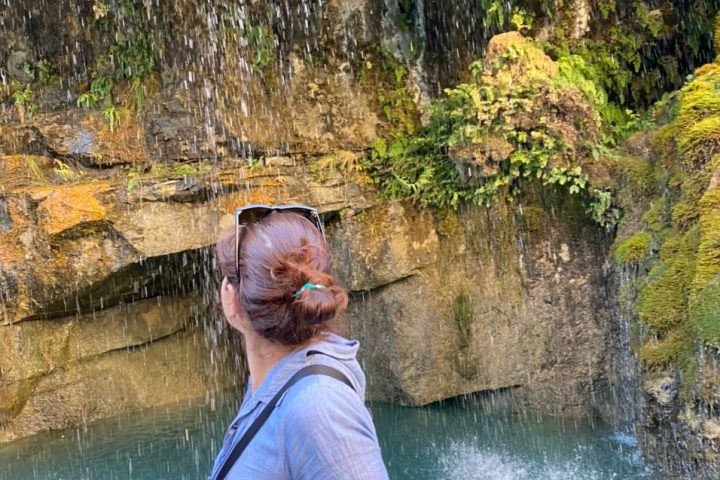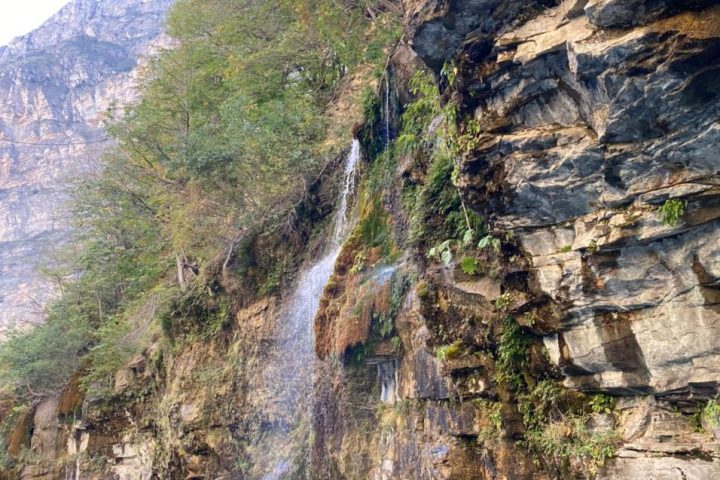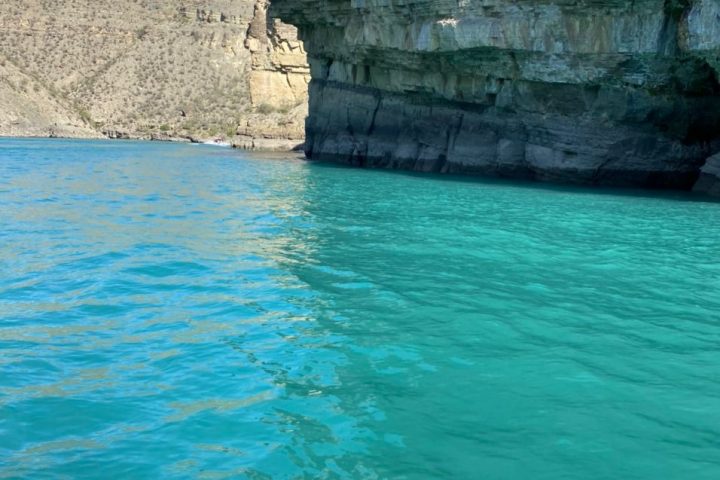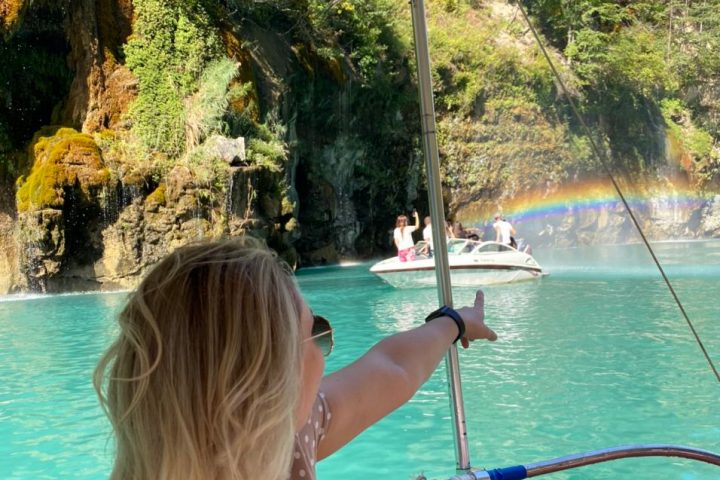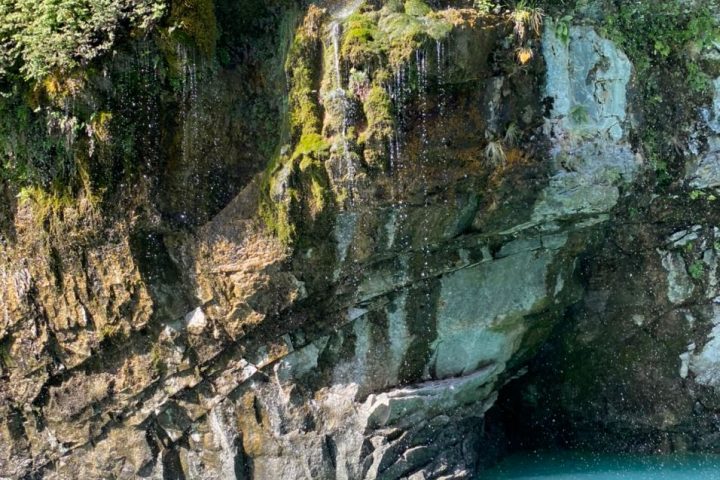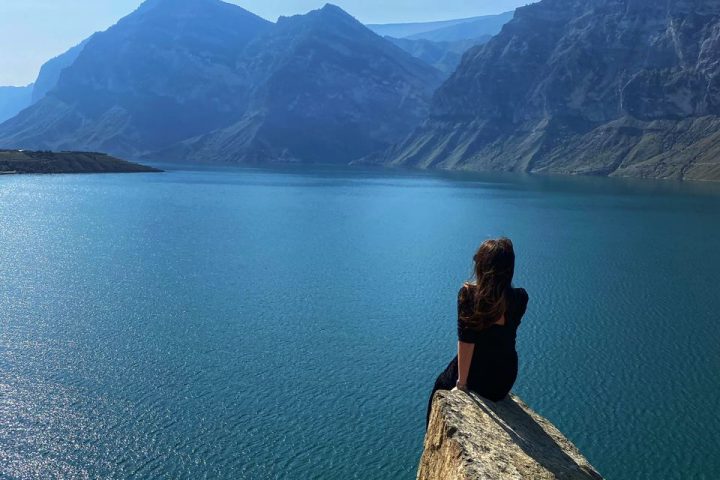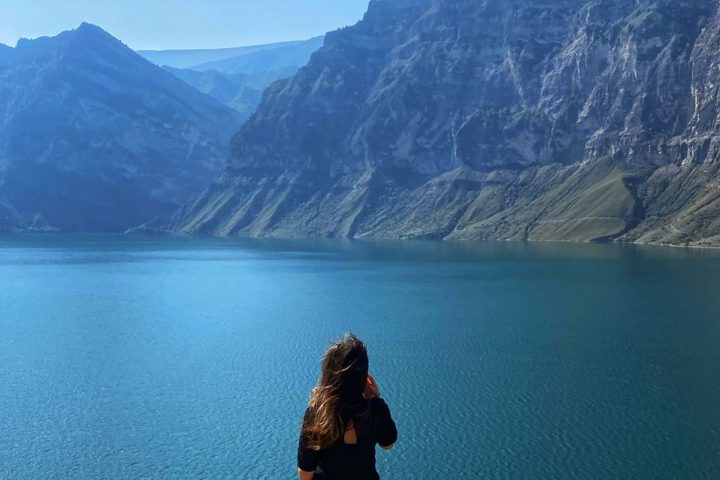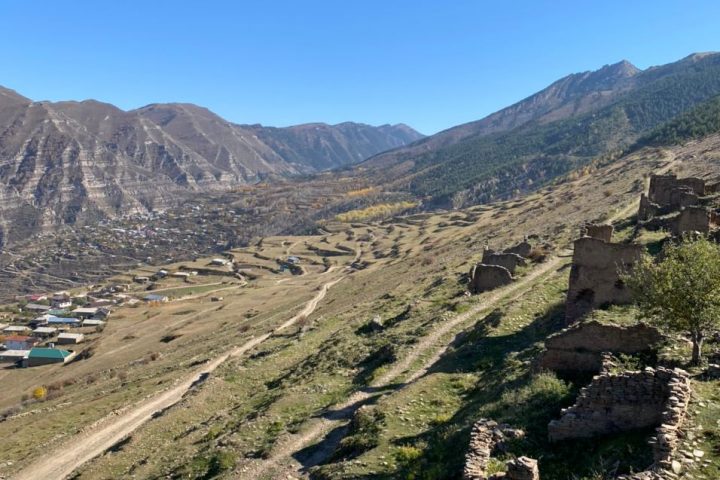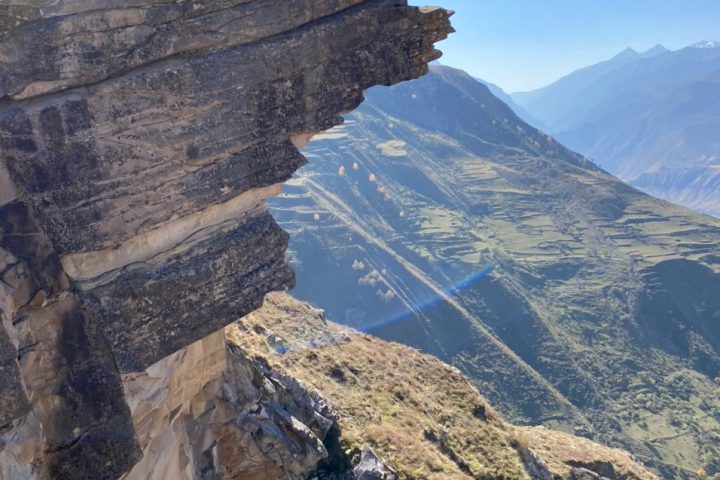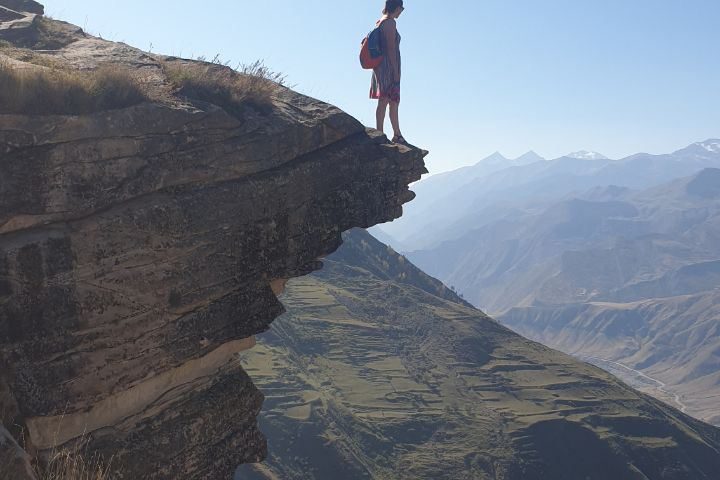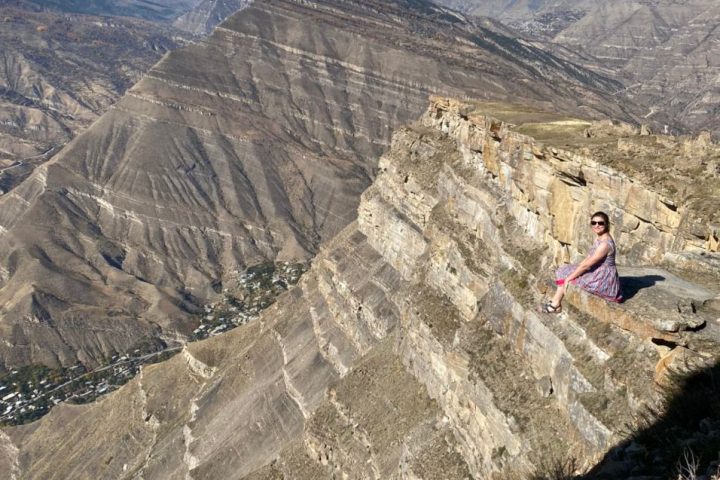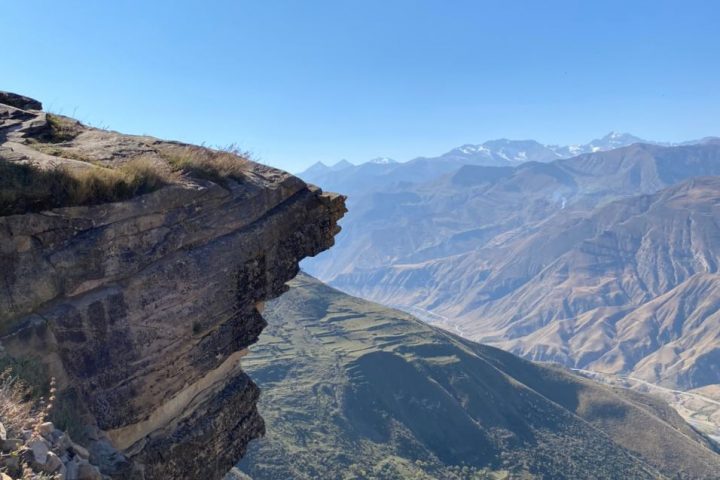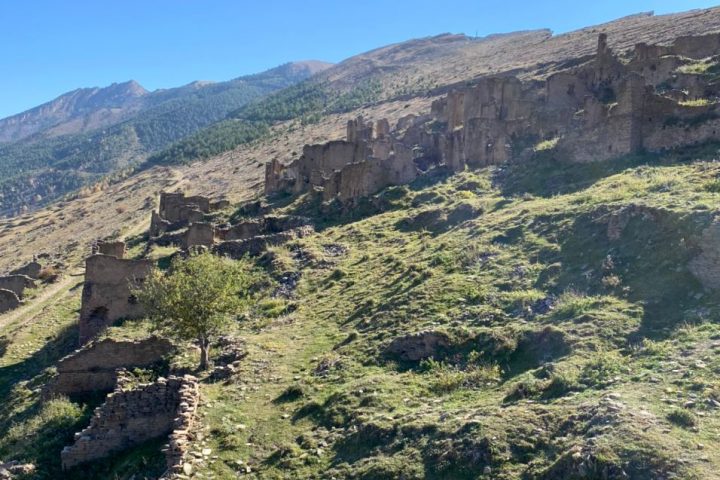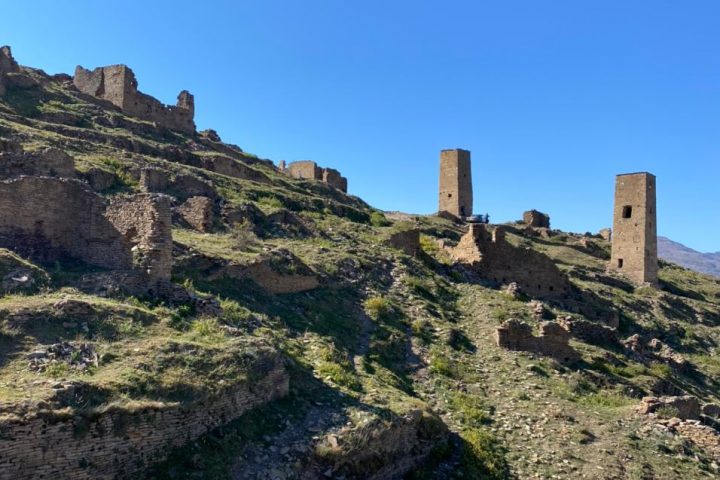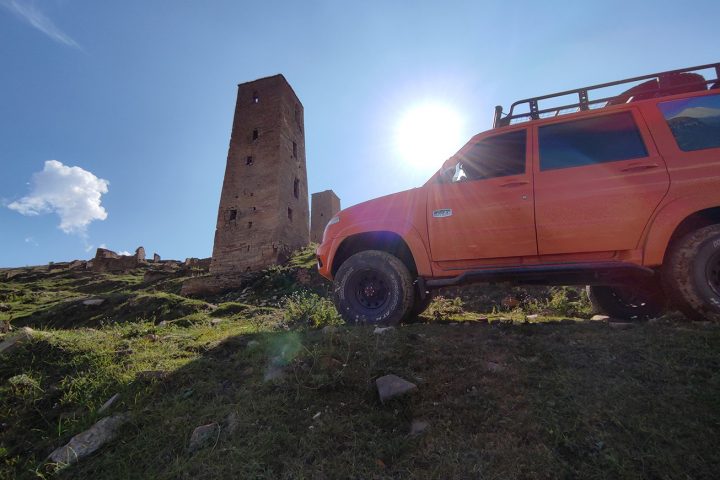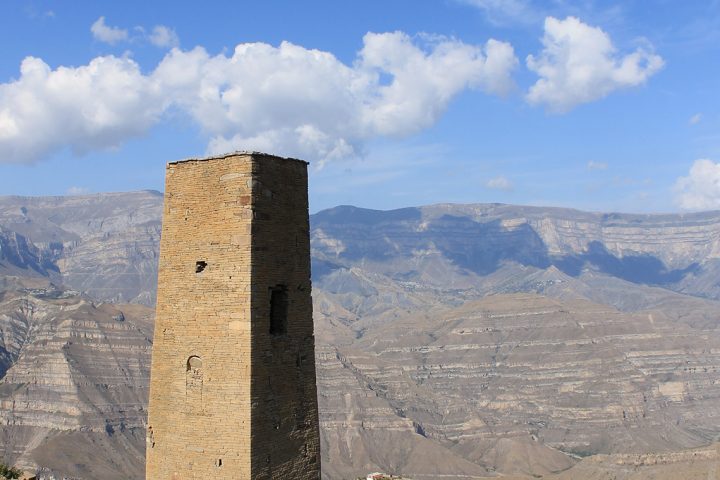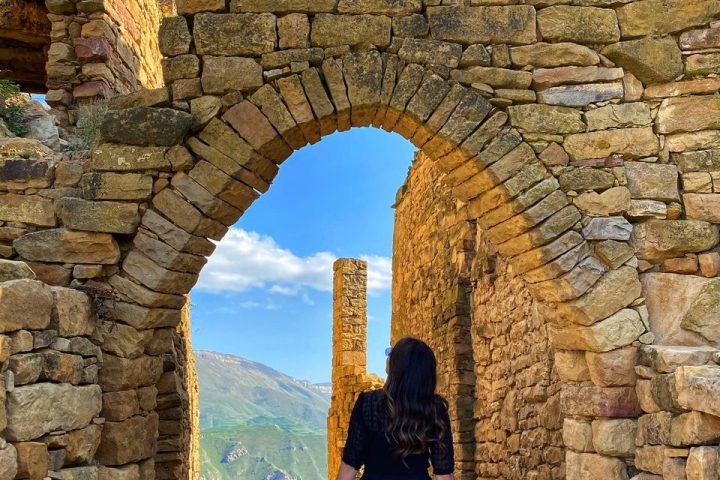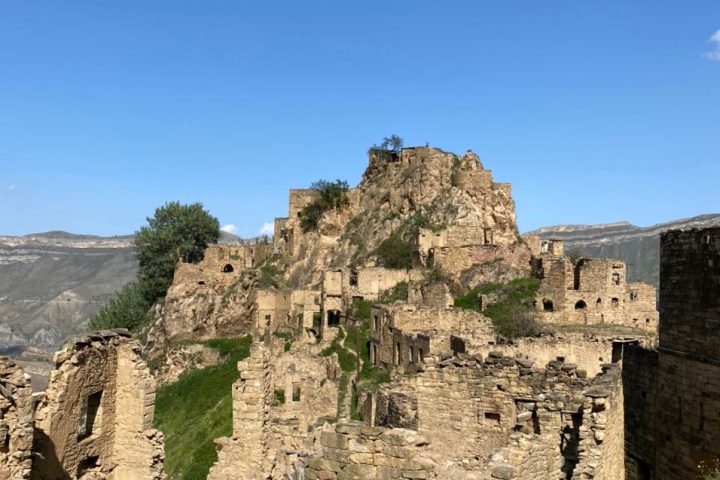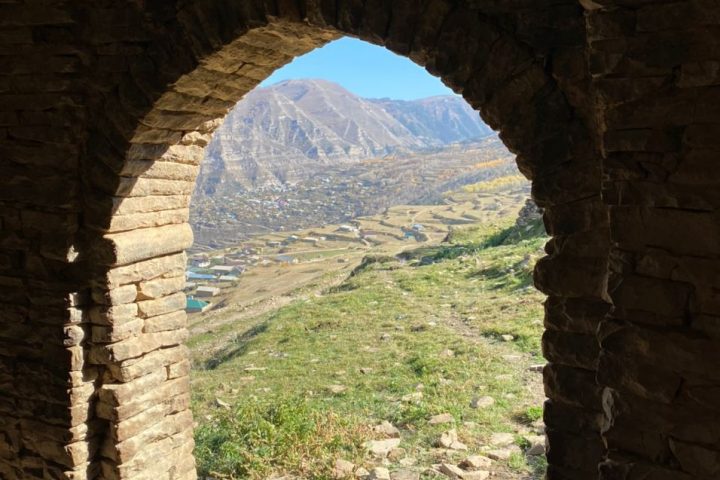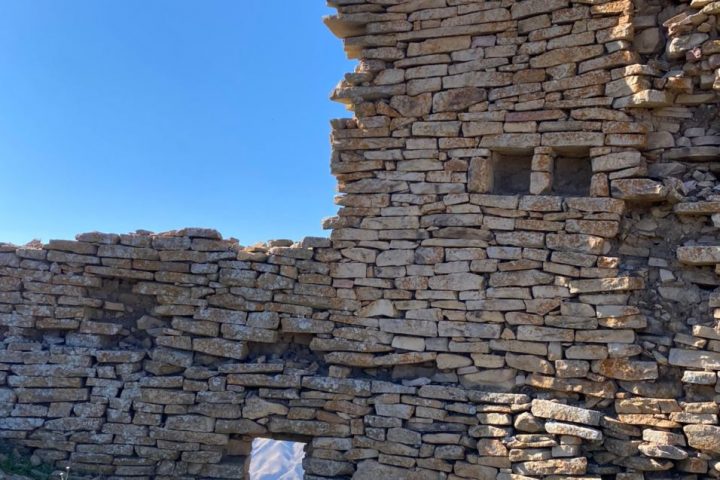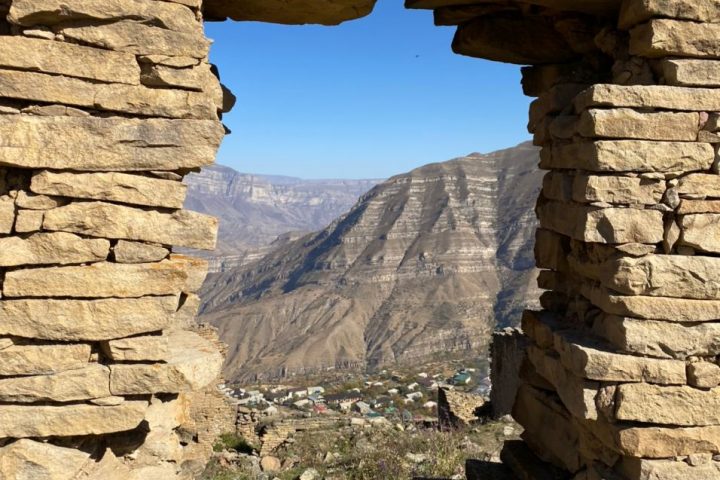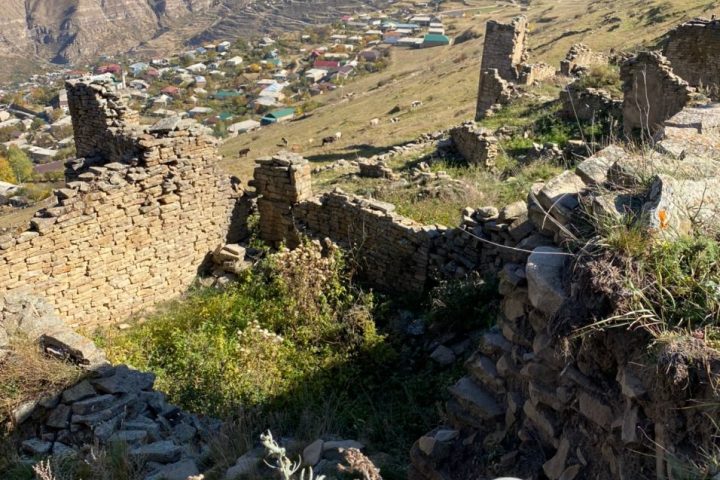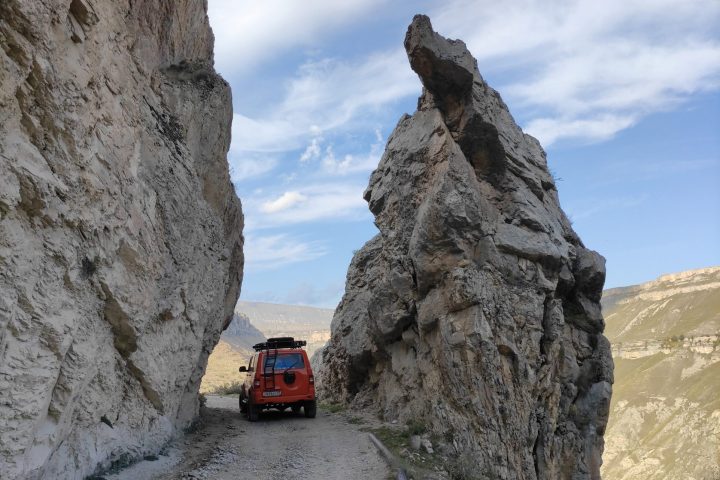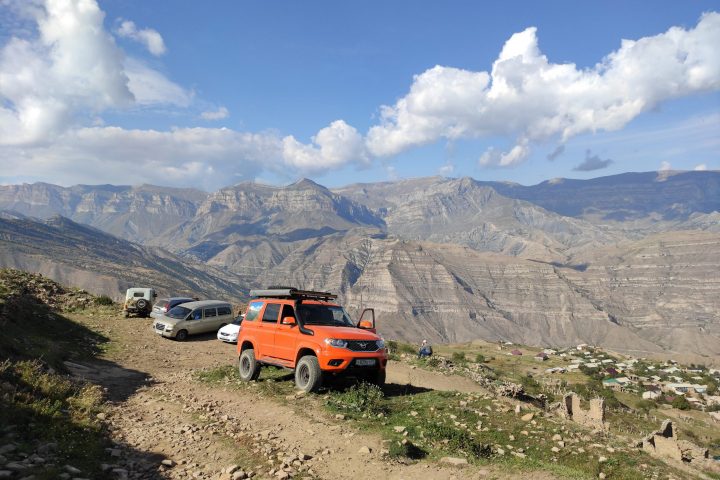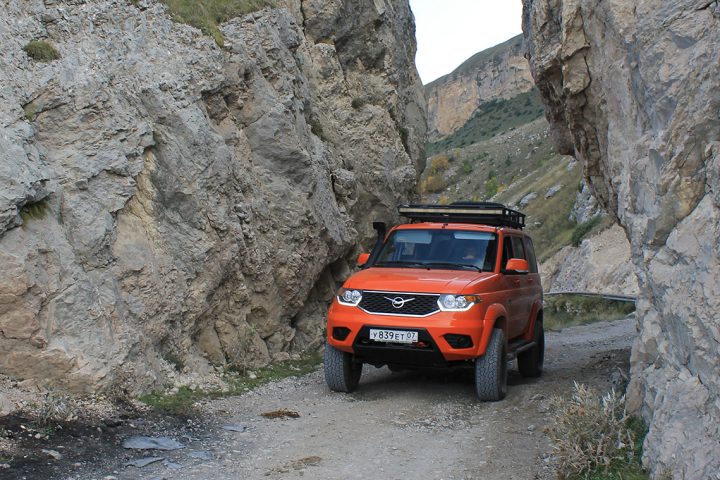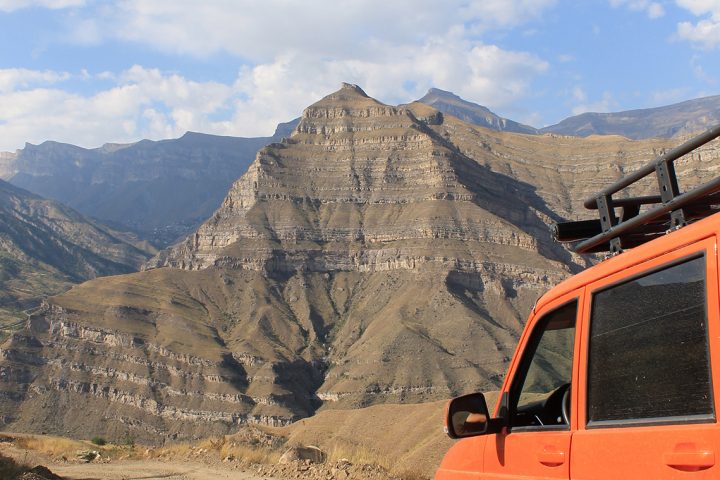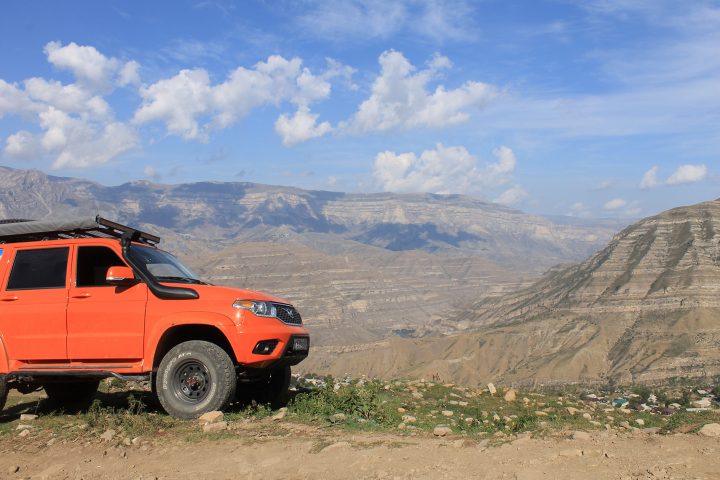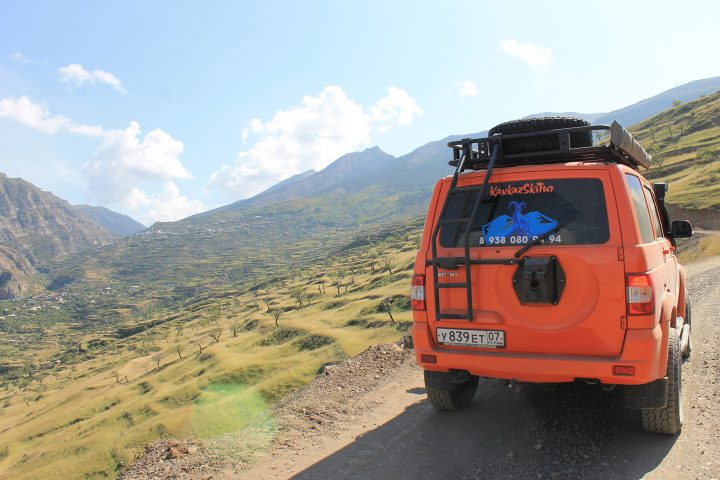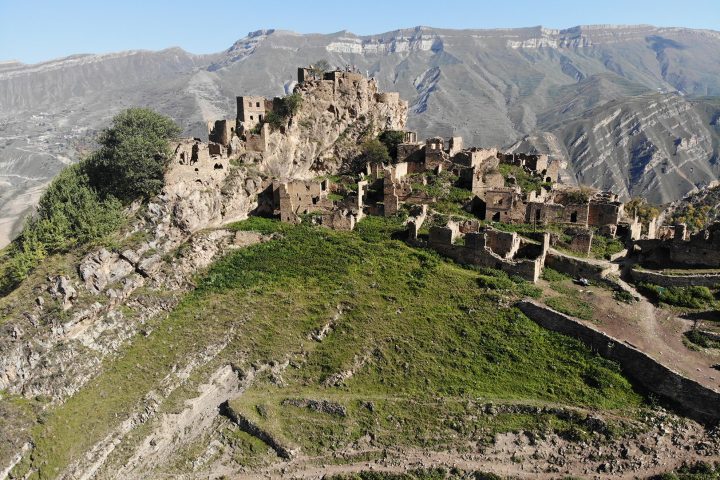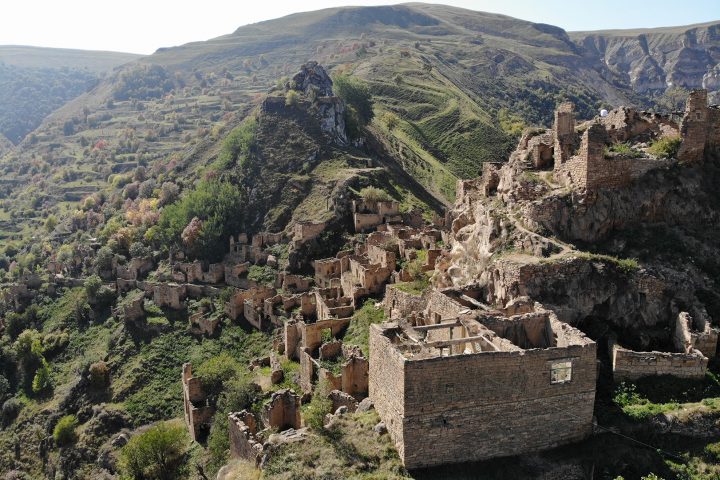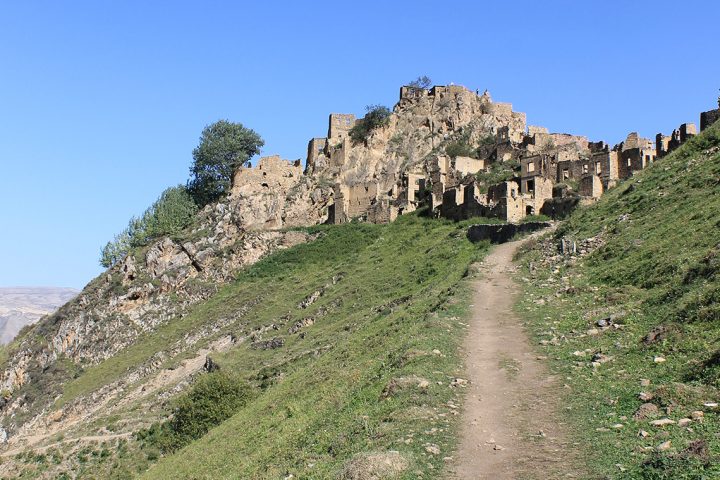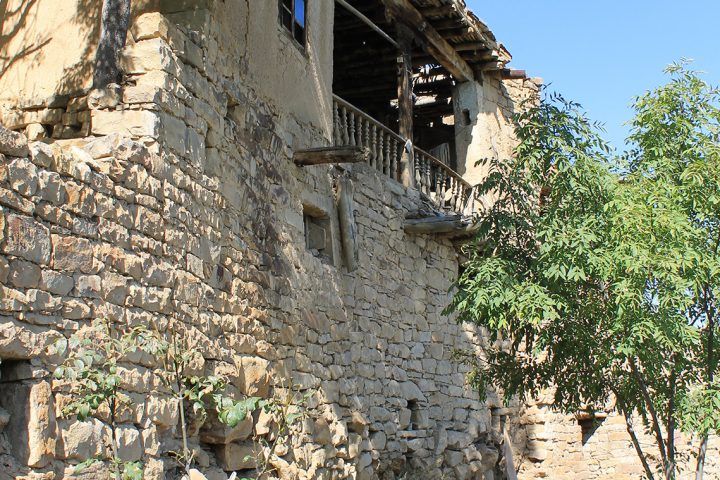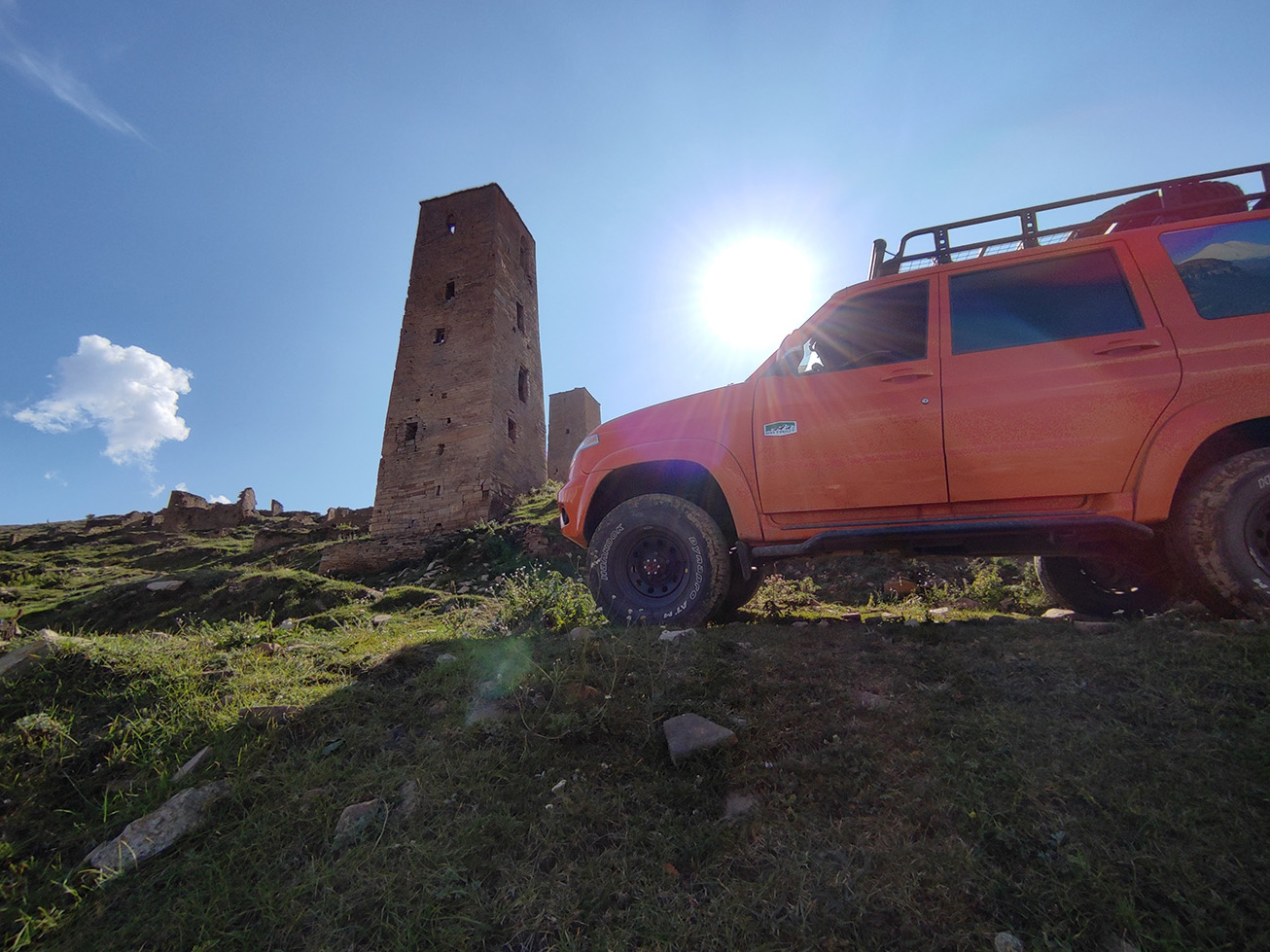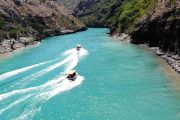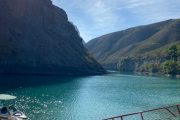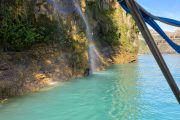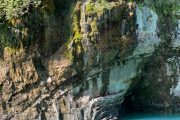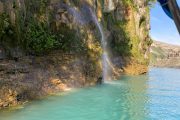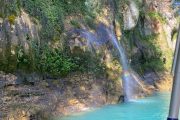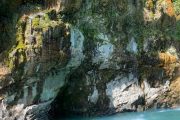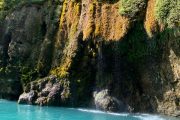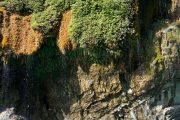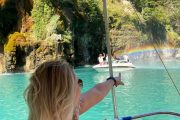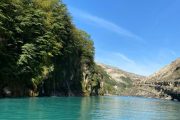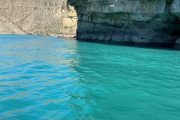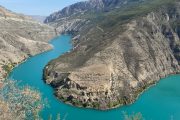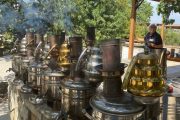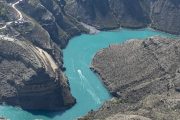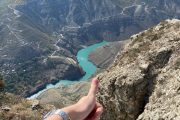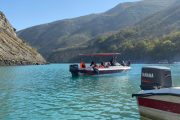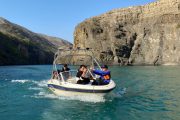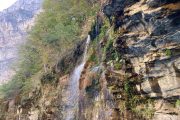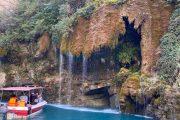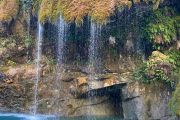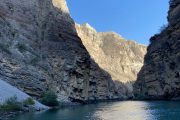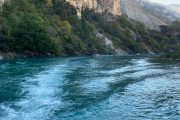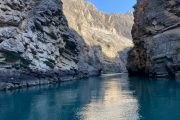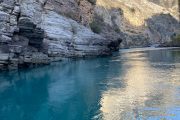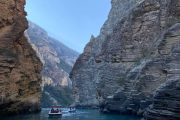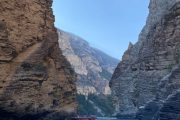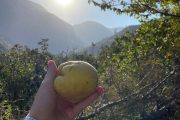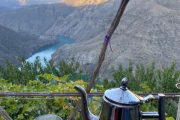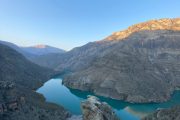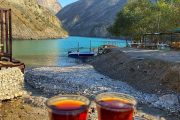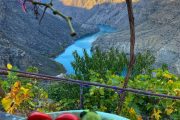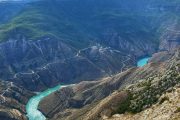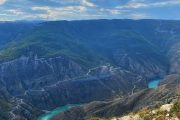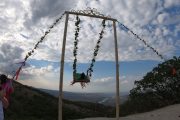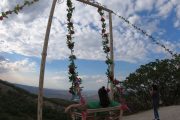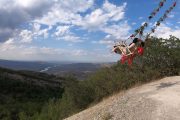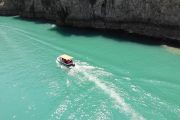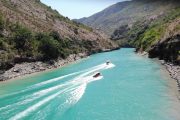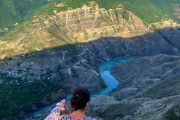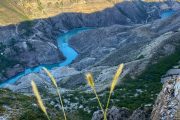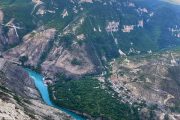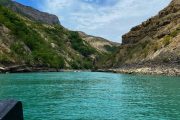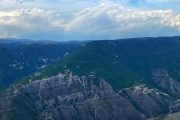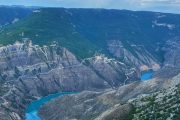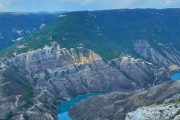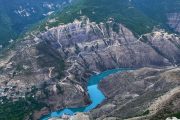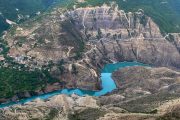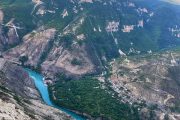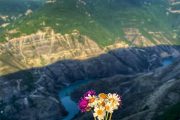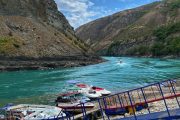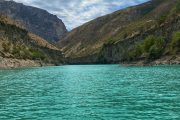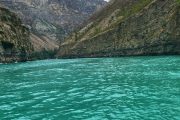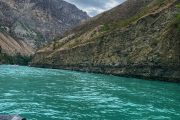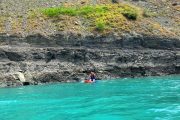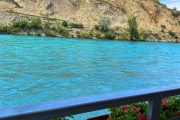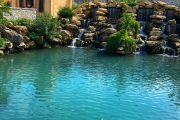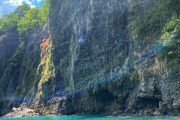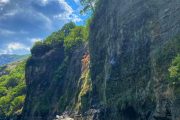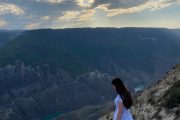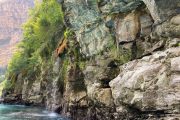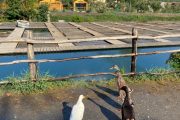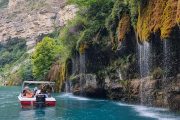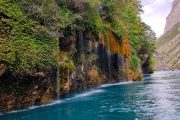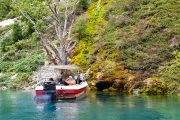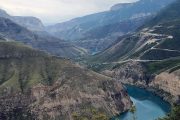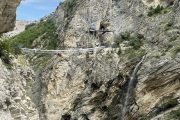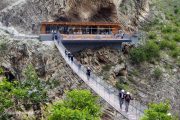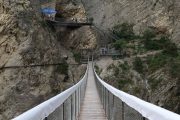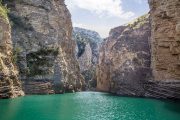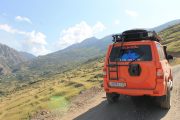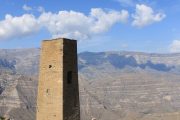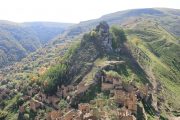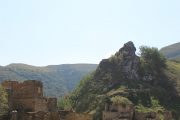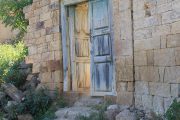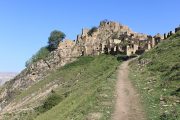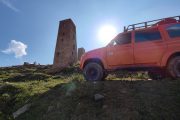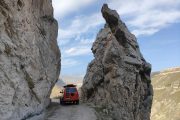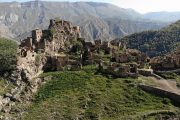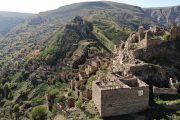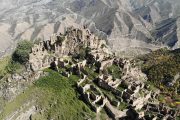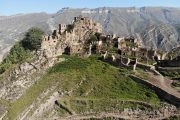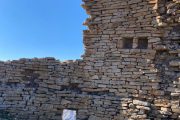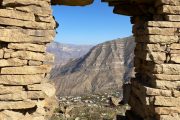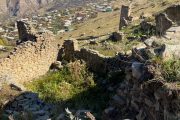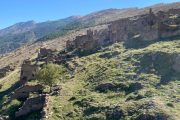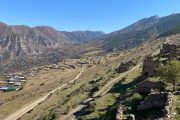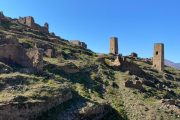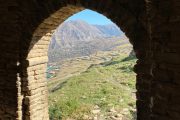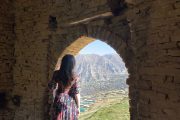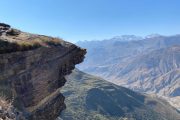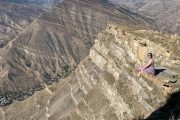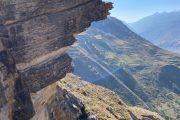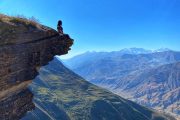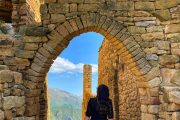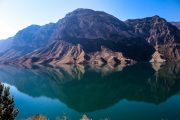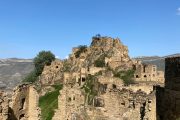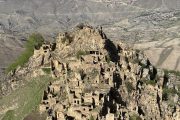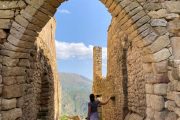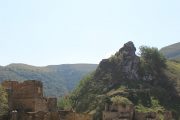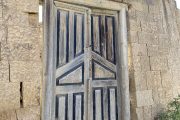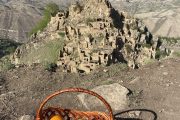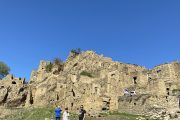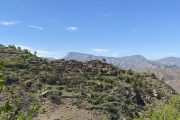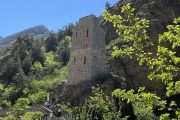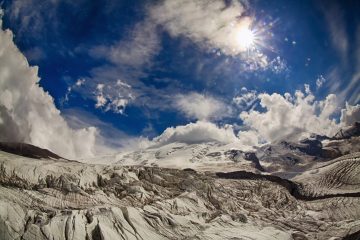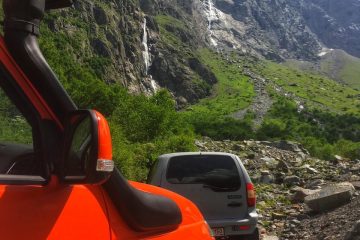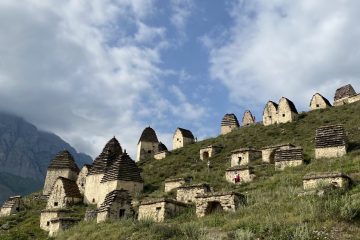We leave Nalchik at 6 am. We have a way through four republics.
The journey till Dagestan takes approximately 5.5 hours.
The trip is possible only for ACTIVE PEOPLE who easily endure the road.
Mountainous Dagestan is an amazing place, a country of mountains and languages. And the Sulak Canyon is its pearl. Such a beautiful place worth seeing. The opportunity arises to look from a height at the beauty of the water surface, framed by mountain peaks. When you stand on the edge of the abyss, around the mountain and only the wind in your face — the feeling is indescribable. Whoever has not seen the Sulak Canyon has not been to Dagestan. Without it, your journey through Dagestan can be considered unfinished. If there is a special spirit of Dagestan in the world, then it certainly lives in this beautiful place and enjoys the beautiful river and the majesty of the mountains. It looks at the world from an eagle’s height and protects its creation!
Having swept through the entire mountainous Dagestan, we fell in love with this republic, where landscapes changed every half a meter. We think everyone should see this. We have laid out the most convenient and interesting route for you. The first point will be the Sulak Canyon, we will stop by the village of Dubki and walk along the upper observation deck to admire the canyon from above and take cool photos on the rocks.
Day one
SULAK CANYON. DUBKI VILLAGE
Many admire the «Grand Canyon» in the US state of Colorado. But few are aware that we have a canyon in Russia, which is even larger, and to see it with your own eyes you do not need to fly across the ocean, and even just leave the country. Incredible space around, the frantic depth of the canyon itself and eagles soaring in the sky. In the distance, on the horizon, you can also see the Chirkey reservoir. At the edge of the cliff there is an observation deck. The height (depth) of the canyon is 1920 meters — almost 2 kilometers! This is more than the mentioned Grand Canyon from the USA and is the 6th most important among all the canyons in the world. If you look closely, you can see small settlements below, the Sulak River meandering along the bottom of the canyon, and even tiny boats sailing along this river.
Not far from the village of Dubki there is a no less picturesque place, one can say the basis of the entire Sulak canyon — the Chirkey reservoir. Be sure to stop by to admire the place around.
Chirkey Reservoir
The Chirkey reservoir is the largest reservoir in the North Caucasus. It is located on the Sulak River. The founding date is 1974. During the creation, several nearby agricultural lands and settlements were flooded: the village of Chirkey and the special settlement of the builders of the Druzhba hydroelectric power station.
The Chirkey reservoir in Dagestan covers an area of 42.5 square kilometers. Its coastline is heavily indented, in places there are canyons and caves. Numerous bays cut into low mountain formations. The reservoir is located in the narrow gorge of the Sulak River. Local scenic landscapes vaguely resemble the fjords of Norway.
The day promises to be busy and then we will go towards the Gunibsky district, on the way we will pass through the longest tunnel in Russia — the Gimrinsky tunnel. The tunnel provides the shortest and weather-independent transport link for the construction of the Irganai hydroelectric power station, as well as 9 regions of mountainous Dagestan with the railway and the center of the republic. The length is 4303 m. The capacity of the Gimrinsky tunnel is 4,000 vehicles per hour. The width of the carriageway is 7 meters, the height of the clearance is 5 meters. We drove along it for exactly 6 minutes)
After the tunnel, picturesque mountain landscapes open up to us, which are breathtaking. A little further than the tunnel we will drive up to the Gimry tower, with its heavy and bloody history, we will definitely go in and plunge into the history of that time. To enter the territory of the tower, girls must definitely put a headscarf on their heads.
Gimry Tower
The Gimry tower is a defensive tower in the village of Gimry, Untsukulsky district of the Republic of Dagestan. Built in the 19th century. One of the samples of the defensive structures of the highlanders of Dagestan, built to defend against the attacking enemy. It is believed that the tower is a witness to the death of Gazi-Muhammad, the first imam of Dagestan.
The tower originally built on this site has not been preserved, only the ruins of the foundation have remained of it. However, in 1997 a new Gimry tower was built here. Inside it is completely empty and you can climb the wooden stairs to the roof, which offers a beautiful view of the surroundings.
The new building is equipped with loopholes and has an observation deck; it looks like an old tower that was once destroyed. There are memorial plaques around, one of which has the following words: “Imam Shamil landed here after jumping from a sakli on the day of the death of the first imam of Dagestan and Chechnya, Gazi-Magomed.”
The tower is famous for the fact that on October 10, 1832, the troops of Baron Rosen approached the village of Gimry and took it. Gazi-Magomed and Shamil, who arrived to help, took refuge in the tower. Rosen’s troops laid siege to the tower and bombarded it until the Highlanders ran out of ammunition. Ghazi-Muhammad rushed to the besiegers and died. Shamil, according to legend, jumped out of the tower far away, finding himself behind the military ring. He miraculously managed to escape from the battlefield.
Having imbued with history, we drive further along the Irganai reservoir, where we will make a stop for a photo. The views there are amazing.
Irganai reservoir
The Irganai reservoir is a reservoir on the Avarskoye Koisu River in Dagestan, created as a result of the construction of the Irganai hydroelectric power station in 2008.
During the creation of the reservoir, 940 hectares of farmland and gardens were flooded, 521 buildings were moved. As a result of flooding, the village of Irganai was completely resettled, and the villages of Zirani and Maidanskoye were partially resettled. As a result of the haste with which the reservoir was filled, only 30% of its bed underwent sanitary cleaning, gardens, houses, outbuildings and cemeteries that had not been cut down went under water.
Climbing the mountains, it is impossible not to stop at this reservoir, which impresses with its majesty of the mountains and the beauty of the water surface.
Old Goor
Thus, with stops, we will reach the Shamil region and climb up the mountain to the village of Goor, where the ruins of the Goor towers and the famous Troll’s Tongue will be waiting for us. The bravest of you will be able to stand on the edge of the Tongue and feel like the Lord of the mountains. But it’s quite life-threatening and we don’t recommend getting close to the cliff! A walk through the ruins of the Goor towers will take you back to ancient times, where many pictures of that time come to your imagination.
Old Goor is one of the attractions of Dagestan. Once it was an impregnable defensive complex of seven towers and residential buildings, located on the top of a mountain, on the edge of a steep abyss. Four towers, including the largest one, 25 meters high, are now destroyed. From their remains, the Highlanders built buildings in the new part of the village, where they began to move in the middle of the 20th century in search of an easier life. The Goor towers have an interesting feature: some leaned at a slight angle, tapering upwards. This made it possible to defend more effectively: during the siege of the village, stones were thrown from the roof, which bounced off the wall for a long distance.
The date of construction of the complex is not exactly known. It is believed to be the end of the 17th century. At the same time, symbols of the pre-Islamic period — Christian and even pagan — can be found on the walls of destroyed buildings. For example, swastika spirals — an ancient symbol from Transcaucasia and Asia Minor — or the symbol of the Cretan labyrinth «Dedalus», named after the character of ancient Greek mythology, artist and engineer. Most of the non-defensive buildings in the old village were also left in ruins. A low building survived, where the graves of two sheikhs, Ramazan and Akhmat-Vali, are located. Now there are events on special occasions.
On this, our first day will come to an end, satisfied and tired, we will go to the village of Chokh, where we will check into a hotel, waiting for the next day.
Day two
In the morning, first of all, we will walk around the village of Chokh.
Aul Chokh
Aul Chokh in Dagestan is known as one of the oldest. A branch of the Great Silk Road probably passed through it — once it was a famous scientific and commercial center. Chokh stands at the crossroads of five roads and is the oldest settlement in the North Caucasus. This region is notable for its inhabitants, among whom there are many professors, academicians, doctors, teachers, and simply highly educated and clever people — this is the historical feature of this village. It was education in this village that was of the highest value for the inhabitants, the Chokhs have long studied in Istanbul and Iranian educational institutions. There was also a palace (Malalov, once the magnificent palace of a local pre-revolutionary aristocrat, now there are only ruins in its place).
Chokh is a residential settlement, although more and more residents leave it every year. But it does not lose its tourist attractiveness from this. The locals are hospitable and they will lure you into visiting, knocking you out of the schedule. Here you can walk for hours, looking at the ancient stone houses with carvings and looking closely at the difficult, but familiar to the inhabitants of the mountain life of the village. The streets of Chokh are narrow and winding, fraught with many secrets of the past, above the front door of each house there is a sign with the family name and the year of construction.
Karadakh Gorge
If you are not lured to visit, we will immediately go further along our route, namely to the Karadakh gorge, one of the most beautiful and popular places in mountainous Dagestan.
We warn you that it is always windy and cool there.
For many years, the waters of the Kvartakh River eroded the limestone rock, and the seemingly impregnable rocks could not withstand this force. Gradually, the water cut through the stone, and as a result, a picturesque gorge was formed, which is called the Karadakh gorge. Now, between the rocky ledges, there is a channel of a mountain river, it looks tiny and it is hard to imagine that its waters could erode the limestone rock in such a way.
However, after heavy rain, the water level can rise by 3-4 meters, and the force of the stream becomes crushing — it picks up huge stones and pushes them. Then the water recedes, the boulders remain where the river left them, but the power of the water flow must be remembered when planning a trip to the gorge — if heavy rain is expected, it is safer to postpone your acquaintance with the unique natural corridor.
The attraction is a gorge with a length of almost half a kilometer and a maximum width of 5 m, stone walls up to 170 m high rise on both sides. While walking between these huge rocks, it can become a little uncomfortable — it seems that the mountains are about to close. In some areas, the rocks really form stone vaults, sometimes boulders are visible between the walls — they flew down the cliff, but got stuck along the way.
After examining this miracle of nature, we will immediately go to the main part of our route — to the ghost village of Gamsutl.
Aul ghost Gamsutl
No matter how many times we have been there, we always want to return there again and again. When we first saw it, having overcome this path on foot up the mountain, we could not believe our eyes, we were in a fairy tale, everything seemed impossible and drawn. Questions immediately arose in my head, how did people live there, what did they do? And after what we saw, the answer came by itself — they were happy there.
Gamsutl is an aul abandoned by the inhabitants, standing alone on the mountain peaks and related to them for hundreds of years. You will have to climb on foot — a steep road leads to a cluster of empty houses and streets, along which only the wind walks.
But it’s worth it: the views will impress anyone. Gamsutl seemed to have grown into the mountains. This is partly true: houses were built so that the rock served as one of the walls. The rest were made from rock fragments. Some houses are two- and even three-story — wealthy people could afford them. But you still have to be careful when walking near them: the masonry is crumbling, and the earthen roofs have already been washed away almost everywhere. There are only a couple of streets in the village. Only a part of the village, which is located on the very top of the cliff, has been preserved — here it is about 1500 meters above sea level.
If you want to feel how time stops and empty windows of abandoned houses look at you, go up to Gamsutl and stand among its streets in silence for at least a couple of minutes.
There used to be watchtowers on the sides of the village. They entered it on folding bridges. It is believed that Gamsutl was never taken by any of the conquerors — it is too impregnable. People left it about 30 years ago, and the last resident, or as he called himself «the mayor of Gamsutl» — Abdulzhalil Abdulzhalilov died in 2015. Since then, interest in the abandoned colorful aul, as if clinging to the mountainside, has only been growing. Hundreds of tourists visit it every day.
Departure
Return back to Nalchik.
The price includes:
travel — 2 full jeep ride days
transport service throughout the route (no additional fees)
Hotel accommodation (twin/dbl rooms)
Additional costs:
personal expenses
food and drinks
boat ride — 600 rubles per person
guide not provided
| PRICE | 15’000 rubles per person | |||
| DEPARTURE TIME | 06:00 am from city Nalchik | |||
| RETURN TIME | 22:00-23:00 next day | |||
| INCLUDED IN THE PRICE |
|
|||
| ADDITIONALLY PAID |
|
|||
| You must have: ✓ Passport, ✓ Snack, ✓ Sports shoes, ✓ Rain clothes Important to know! If weather conditions are unfavorable for the tour, then changes to the planned route are possible, including the day and time of departure. |
||||


 +7 928 691 44 05
+7 928 691 44 05 
 Russia, KBR, city Nalchik
Russia, KBR, city Nalchik




